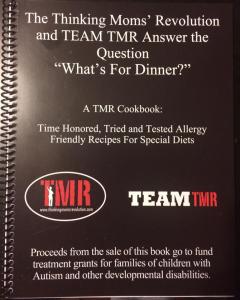 My son does not like to eat. He apparently hates putting food in his mouth. Unless it consists of a lot of sugar, a bit of fat and a lot of carbohydrates, preferably with added chocolate. Then I’ve got a very good likelihood of it going in his mouth, but there’s still no guarantee.
My son does not like to eat. He apparently hates putting food in his mouth. Unless it consists of a lot of sugar, a bit of fat and a lot of carbohydrates, preferably with added chocolate. Then I’ve got a very good likelihood of it going in his mouth, but there’s still no guarantee.
He’s fussy about texture, about temperature, about the way it looks, about the way it feels, and the way it smells. When I say ‘fussy,’ I should really say paranoid – ‘fussy’ just doesn’t begin to describe what autism can do to a child’s normal pleasure in eating. I’ve thrown out more rejected food than has ever gone into his mouth – we have the healthiest dogs and compost bin to prove it.
 A lot of you out there have kids similar to mine – where you eventually get to the point that you just feed them apples (insert favourite food here) all day long just so they’ll eat something! So, what can you do?
A lot of you out there have kids similar to mine – where you eventually get to the point that you just feed them apples (insert favourite food here) all day long just so they’ll eat something! So, what can you do?
I wish I could tell you. My son is still not eating reliably, despite three years of effort on my part. So I’m certainly no expert in successful methods of getting a child to eat! What I can do is share some of the information I have ingested (bad taste pun there, I know) in the hope that something may work for YOUR child. Please make sure to share any other ideas and resources in the comments section, as I’m still looking for answers!
1. Food could be the culprit.
Some foods act like drugs in our children’s bodies. Intestinal permeability (leaky gut) can mean that improperly digested food (in the form of peptides) can pass through the gut wall. From there, they can cause a host of problems, including immune system dysregulation, inflammation and further food sensitivities. They can also provide the child with a ‘high,’ which will cause them to crave the offending food repeatedly. Most Thinkers know that gluten and casein products are the main culprits. Other foods can also cause issues for your child however – innocent looking foods like eggs, nuts, honey, cocoa, rice, potatoes, tomatoes, and the list goes on.
What can you do?
 Educate yourself about foods and their potential to turn into toxins. Research different diets and substances that may need to be avoided. Learn about the possible effects of salicylates, amines, FODMAPs, nightshades, oxalates, and phenols. Some of my favourite books:
Educate yourself about foods and their potential to turn into toxins. Research different diets and substances that may need to be avoided. Learn about the possible effects of salicylates, amines, FODMAPs, nightshades, oxalates, and phenols. Some of my favourite books:
Nourishing Hope for Autism, by Julie Matthews
Special Diets for Special Kids, by Lisa Lewis
Gut and Psychology Syndrome, by Dr. Natasha Campbell-McBride
The Kid-Friendly ADHD & Autism Cookbook, by Pamela Compart and Dana Laake
Keep a food diary of anything that goes into your child’s mouth, along with notes on their behaviour, sleep, poos (our favourite topic) and anything else you notice. This could give you a clue as to which foods could be a problem for your child.
There are also allergy or intolerance tests that you can do – via blood tests, scratch testing and even hair analysis. Some practitioners can also assess foods through energy or vibrational testing.
2. Medical issues could cause lack of hunger, food refusal or inability to eat.
Insufficient zinc can cause taste buds to not be detecting the taste of food properly. If your child is constipated, they may not want to add more food to their overloaded bodies. A child with reflux will stick to foods that are less likely to be brought up again. Yeast can cause a child to crave sugars and carbohydrates. Your child’s body may not be sending or receiving the right signals to let them know they are hungry. The complex system of chewing, moving the food around the mouth and swallowing may not be coordinated enough to enable the child to actually eat their food.
What can you do?
 Work with your healthcare practitioner to determine if any medical issues could be the culprit of your child’s eating. This may be through testing nutritional and pathogen status, checking for faecal loading, or working with a feeding therapist and/or speech therapist to ensure there are no physical reasons for your child’s eating problems.
Work with your healthcare practitioner to determine if any medical issues could be the culprit of your child’s eating. This may be through testing nutritional and pathogen status, checking for faecal loading, or working with a feeding therapist and/or speech therapist to ensure there are no physical reasons for your child’s eating problems.
Some of my favourite books:
Finicky Eaters: What to do When your Kids won’t Eat! , by Lori Ernsperger and Tania Stegen-Hanson
Picky Eating Solutions, by Betsy Hicks
3. Sensory or behavioural issues could be stopping your child from trying new foods.
Autism comes with a host of sensory issues. Many children do not want to try new foods as they don’t like anything ‘different.’ Sometimes they make up rules in their own heads as to what they will eat and what they won’t. They may have tried a food with a similar colour or smell in the past and had an episode of reflux afterwards, so now all those foods are associated with pain. Whatever the reason, some kids need help to be willing to try new foods.
What can you do?
Gut and Psychology Syndrome (listed above) has a great chapter on helping your child try new foods using applied behaviour analysis methods. If you are already seeing a behavioural therapist, work with them to get your child used to new foods. Once again, various health professionals may be able to help you – but make sure they have experience with children similar to yours.
 For a lot of children, this is an extremely long, drawn-out process, with many steps involved from first tolerating a food, to actually putting it in their mouths. Desensitize your child – have them play with food (‘pretend food’ if need be), use iPad apps dealing with food, have them help you in the vegetable garden or preparing the family meals. One very gentle system that uses this approach is SOS Feeding Therapy.
For a lot of children, this is an extremely long, drawn-out process, with many steps involved from first tolerating a food, to actually putting it in their mouths. Desensitize your child – have them play with food (‘pretend food’ if need be), use iPad apps dealing with food, have them help you in the vegetable garden or preparing the family meals. One very gentle system that uses this approach is SOS Feeding Therapy.
All of these approaches take time, a lot of determination, and a whole heap of patience and persistence. Unfortunately, there are also no guarantees that they will work for your child.
There are some things you can do straight away, while you’re doing your research and making changes.
1. Cut out toxins.
Check that the foods your child is willing to eat do not contain GMO’s, pesticides or additives that will damage their gut further. Use organic where you can afford to, and check the Environmental Working Group’s list of Dirty Dozen and Clean Fifteen before buying your fruit and vegetables.
Educate yourself about the dangers of GMOs and what they do to your body. For a great resource, read Mama Mac’s blog on GMOs and the Rise in Allergies, Superbugs and Childhood Diseases.
2. Add in goodness – also known as “sneaking stuff in.”
Did you know that you can make pancakes with chicken stock instead of non-dairy milk or water? A few tablespoons of pureed vegetables aren’t even noticeable in muffins. If you have a child who will drink smoothies, I will be insanely envious, and you can do a quick Google to find hundreds of smoothie recipes for sneaking in added nutrition.
My son lives on homemade bread. Literally. For months it was the only food we could get him to eat. So I added in goodness. We use chicken stock, vegetable stock, coconut oil, seed meals, protein powder, eggs (before we found out he was intolerant), kelp, and sunflower lecithin. Sneak in whatever you can, whenever you can – as long as it doesn’t stop your child from eating!
3. Have everyone in the house eat the same diet.
My son can sniff out gluten anywhere. If it has gluten and sugar combined, he’s sure to have an internal alarm go off as soon as it enters the house. For my sanity and his health, our rule is that all the food in our house is safe for my son to eat. Once we removed all those temptations, everyone started eating much healthier. I’m lucky in that we homeschool; so my children’s access to food is restricted to what I buy.
Over the last three years since enforcing that rule, my daughters now eat vegetables. Willingly. We’re no longer eating as much sugar – when you have to make or bake it yourself you tend to eat less. I’ve also noticed that my son will be more likely to eat other things if his favourites are not available.
The thing I’ve found most helpful in policing our pantry, is that I can no longer give in to my son when he is craving one of his favourite sugary foods. Those days where he would go all day without eating a single bite, and I would hand him a Gingernut biscuit in despair, are gone. I’ll make him some pancakes instead – with chicken stock, pureed vegetables and extra protein powder of course.
When I first decided to change our entire family’s diet over, we had help from a diet coach. She educated us about the effects of certain foods, guided us through the ‘special diet maze,’ provided us with recipes and gave us tips on how to change foods over to healthier alternatives. Since then she has become a great friend – and fellow Team TMR Australia member. She is also featured in the upcoming TMR GMOs, Organics and Food Allergies eConference.
 Which is the final tip I will leave you with – attend the eConference! A lot of the information I have touched on above will be covered in more detail in the eConference. You will also get a live cooking demo and a copy of TMR’s brand new Allergy-Friendly eCookbook.
Which is the final tip I will leave you with – attend the eConference! A lot of the information I have touched on above will be covered in more detail in the eConference. You will also get a live cooking demo and a copy of TMR’s brand new Allergy-Friendly eCookbook.
Educate yourself, be patient, persist, and take a deep breath. Tomorrow is another day and another chance to change your child’s eating habits for the better!
~ Peacemaker
Peacemaker is a mum to 6 children. Three of her girls have been diagnosed with Asperger’s, and one of her sons has severe autism. Their quirky family lives in Australia, where every day presents a new dietary challenge. When she’s not busy homeschooling her kids, Peacemaker can be found researching autism, or reading a relaxing autism biography.

















Pingback: Can I just stop Eating? | Autism with a large dose of Chocolate